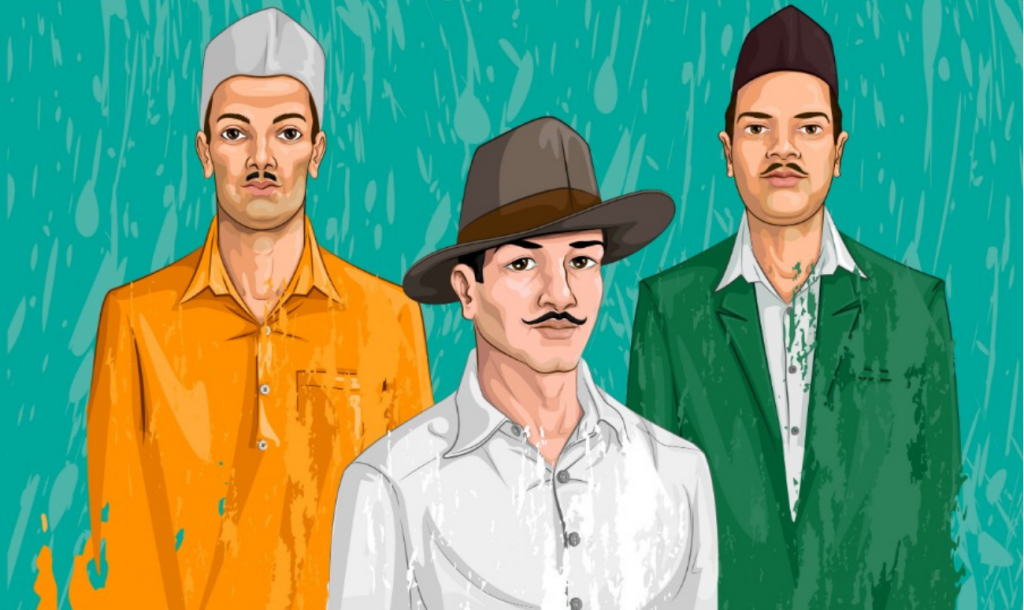The Roar of Revenge – How Bhagat Singh and Rajguru Avenged Lala Lajpat Rai’s Death
The Execution of J.P. Saunders in Lahore, 17 September 1927
In the stormy chapters of India’s freedom struggle, there are moments that burn through time like fire. One such moment was the assassination of British police officer John P. Saunders by Bhagat Singh and Rajguru — an act of revolutionary retaliation for the brutal lathi-charge that led to the death of Lala Lajpat Rai, the revered nationalist leader known as the “Lion of Punjab.”
Though often remembered for their later dramatic bombing of the Central Legislative Assembly, Bhagat Singh and his comrades’ first act of direct defiance was in Lahore, on 17 September 1927, when they struck down the symbol of colonial brutality — not out of hate, but out of a deep love for a nation under chains. This was not a crime. It was, in their eyes, an act of justice.
The Death of a Patriot: Lala Lajpat Rai
The seeds of this revolutionary act were sown on 30 October 1928, when the Simon Commission arrived in Lahore. The Commission, set up by the British to discuss constitutional reforms, included no Indian members — a deliberate insult to India’s political aspirations. In response, a nationwide protest erupted.
In Lahore, Lala Lajpat Rai led a large non-violent procession against the Commission. As the march reached the Lahore railway station, it was attacked by police under the command of Superintendent James A. Scott. Rai was severely beaten with lathis (batons), suffering injuries to the head and chest.
Though he remained defiant, famously saying, “Every blow struck at me will prove to be a nail in the coffin of British imperialism,” his health deteriorated rapidly. On 17 November 1928, just 18 days after the assault, Lala Lajpat Rai died. Official reports denied any connection between the lathi charge and his death — but for the revolutionaries, the British Raj had committed a murder in broad daylight.
A Mission of Justice: Planning the Retaliation
For the young revolutionaries of the Hindustan Socialist Republican Association (HSRA), Lala Lajpat Rai was more than a leader. He was a father figure. His death was a personal wound.
Bhagat Singh, Shivaram Rajguru, Chandrashekhar Azad, and others resolved to avenge Rai’s death. Their original target was James A. Scott, the officer who had ordered the lathi charge. A plan was drawn: they would eliminate Scott and send a message to the Empire — Indian blood will not be spilled in vain.
But the plan took an unexpected turn. On 17 December 1928, mistaking J.P. Saunders, a young Assistant Superintendent of Police, for Scott, Bhagat Singh and Rajguru shot him dead outside the Lahore District Police Headquarters.
It was a case of mistaken identity — but it didn’t change the mission. The British officer represented the same system of oppression. Revenge had been delivered.
The Execution: The Assassination of J.P. Saunders
At around 4:30 PM on 17 December 1928, Saunders emerged from the police station on his motorcycle. Rajguru, a skilled marksman, fired the first shot, hitting Saunders in the head. Bhagat Singh followed up with additional shots to ensure he was dead.
As police constable Chanan Singh attempted to chase them, Chandrashekhar Azad, who was providing cover, shot him as well.
The entire operation was executed with military precision. The revolutionaries escaped the scene disguised as Westerners, and Bhagat Singh famously cut his hair and shaved his beard to avoid recognition — a dramatic sacrifice for a devout Sikh, underlining his total dedication to the cause.
More Than Revenge: A Revolutionary Statement
While it may appear as an act of vengeance, the assassination was much more than personal retaliation. For Bhagat Singh, this was the beginning of a wider revolutionary war — not just against individuals, but against an entire imperial structure.
It was a message: Indian youth were no longer afraid.
They would no longer write petitions or beg for dominion status. They would strike back, even at the heart of colonial authority, and awaken the sleeping spirit of a subjugated people.
After the assassination, Bhagat Singh left a note — unsigned, but unmistakable in tone — claiming responsibility, and stating that this was an answer to the death of a national leader, and a warning to the British Raj.
Aftermath: Shock, Hunt, and the Rise of a Legend
The British government was stunned. Lahore was thrown into panic. A massive manhunt began. Police raided homes, arrested hundreds, and launched a crackdown on revolutionary networks across northern India.
Bhagat Singh and his comrades went underground. For months, they continued working within the HSRA. It was during this period that they planned the Central Assembly bombing (April 1929) — an act intended not to kill, but to “make the deaf hear”, by throwing harmless bombs and shouting slogans of freedom.
Eventually, Bhagat Singh surrendered, accepting arrest to use the courtroom as a stage for revolution. But the assassination of Saunders remained the first major turning point in his journey — the act that transformed him from an underground rebel to a national icon.
Legacy: From Martyrs to Immortals
Though Bhagat Singh, Rajguru, and Sukhdev were eventually tried and executed in March 1931, their names echo louder today than many of those who ruled. The killing of Saunders was not just about revenge — it became a spark that lit the fire of resistance in a new generation.
British newspapers painted them as terrorists. But for the people of India, they were heroes, revolutionaries who had the courage to challenge the might of the Empire not with politics, but with principled, targeted action.
Final Thoughts: A Moment Etched in History
17 December 1928 wasn’t just the day a British officer was assassinated. It was the day India’s freedom struggle crossed a threshold. From passive resistance to active revolution. From negotiation to sacrifice.
Bhagat Singh and Rajguru didn’t act out of hate. They acted out of love — love for Lala Lajpat Rai, for their people, and for the dream of an India where no foreign power could ever again strike down a leader and walk away without consequence.
They wrote that message in blood — not as murderers, but as martyrs of a nation still unborn.


+(4)_13122022001446.png&ehk=uHLDsOXcbLm5eKKvQbnL2vx0u53OEnxai%2bpDCG5ARS4%3d&risl=&pid=ImgRaw&r=0)
